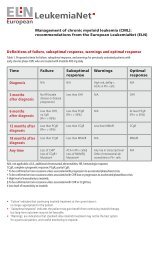Gracial ProdMonograph_cover - epgonline.org
Gracial ProdMonograph_cover - epgonline.org
Gracial ProdMonograph_cover - epgonline.org
Create successful ePaper yourself
Turn your PDF publications into a flip-book with our unique Google optimized e-Paper software.
Safety aspects<br />
On balance, this study is very reassuring. The finding that use<br />
of the Pill does not increase the overall lifetime risk of breast<br />
cancer is very positive, as is the fact that breast cancer in<br />
users or former users of OCs is less likely to have metastasized<br />
at the time of diagnosis. The risk of having breast cancer<br />
diagnosed is slightly increased in current users of the Pill, but<br />
not in those who used an OC 10 years ago. This suggests that<br />
the Pill does not initiate cancer of the breast because the risk<br />
of cancer following exposure to known carcinogens depends<br />
upon the amount and overall duration of exposure and not<br />
upon the length of time elapsed since exposure. It has been<br />
hypothesized that the increased risk of breast cancer in<br />
current users could reflect a higher likelihood of diagnosis as a<br />
result of more frequent professional surveillance and selfexamination<br />
in Pill users. Alternatively, the Pill may be acting<br />
as a promoter of pre-existing breast cancer, thereby advancing<br />
the time at which it becomes clinically detectable (but<br />
conversely reducing its tendency to metastasize). It is not<br />
possible to infer from these epidemiological data whether the<br />
observed relation between breast-cancer risk and OCs is due<br />
to an earlier diagnosis of breast cancer in ever-users, the<br />
biological effects of OCs or a combination of reasons.<br />
Confirmation from experimental studies is necessary.<br />
OC use and<br />
cervical cancer<br />
OC use and<br />
ovarian cancer<br />
Cervical, ovarian and endometrial cancer<br />
The relationship between cervical cancer and OC use is still<br />
inconclusive. Although a slightly elevated risk of cervical<br />
cancer has been reported with OC use (Brinton 1991;<br />
Zondervan et al 1996), it is difficult to adjust for the<br />
confounder of sexual activity, as having multiple partners is a<br />
known risk factor for cervical cancer.<br />
A study by Stanford (1991), investigating the risk of epithelial<br />
ovarian cancer with OC use, showed that in women who have<br />
ever used an oral contraceptive, the risk of ovarian cancer was<br />
reduced by 30%. In addition, five or more years of use was<br />
associated with a 50% reduction in risk. This protective effect<br />
persisted for ten years or more after beginning use of OCs.<br />
A second investigation confirmed this finding (Vessey and<br />
Painter 1995). In comparison with never-users, the relative<br />
risk of ovarian and endometrial cancer in users of OCs was<br />
0.4 (95% CI 0.2–0.8) and 0.1 (95% CI 0.0–0.7), respectively.<br />
There was also a strong negative relationship between the<br />
duration of oral contraceptive use and ovarian-cancer risk, i.e.<br />
in comparison with never-users, the relative risk in users of<br />
40
















